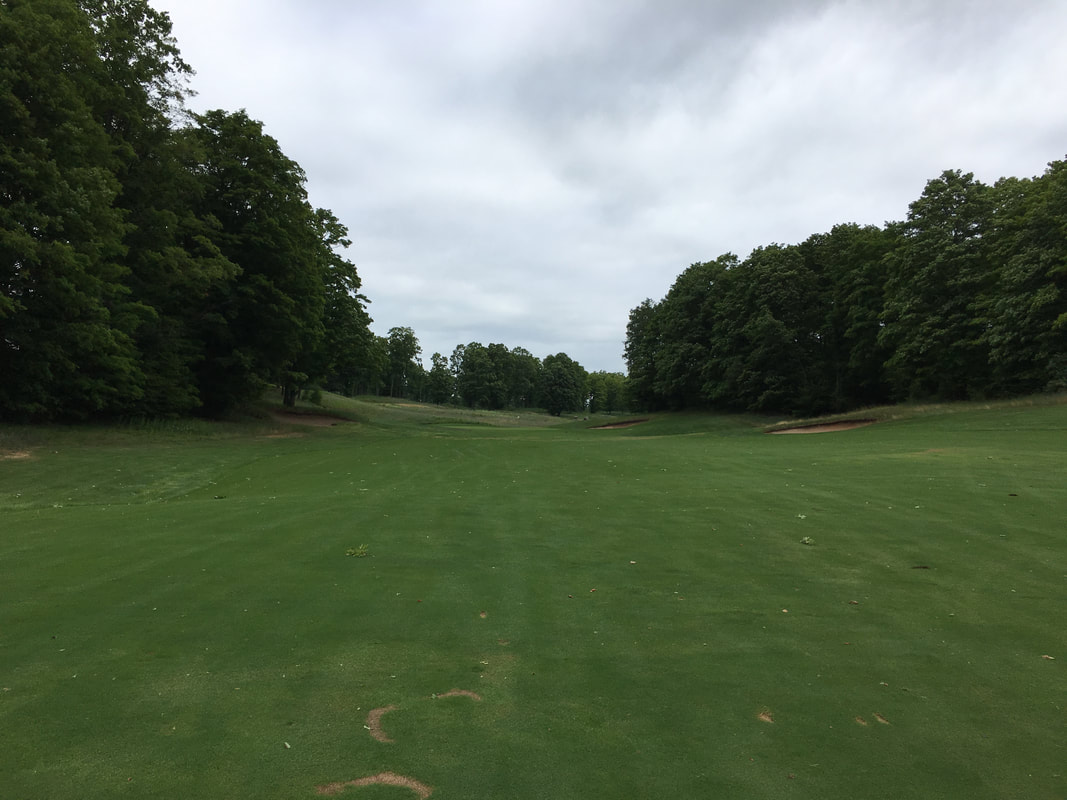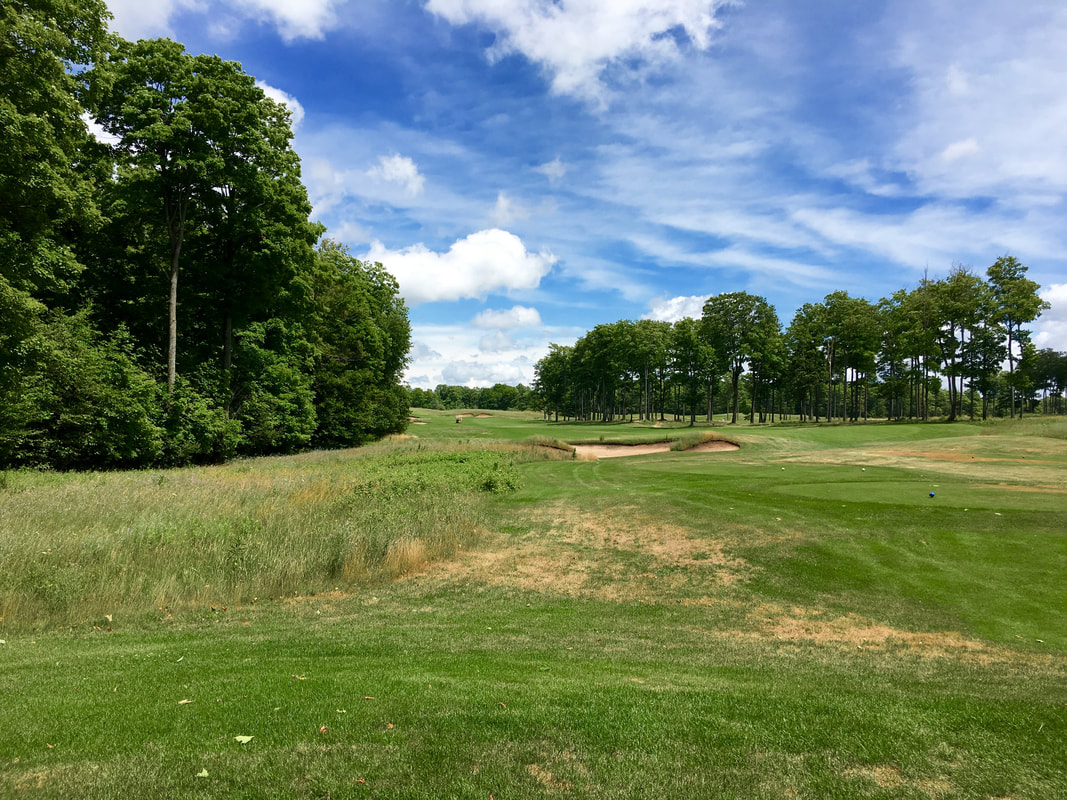The fourth full-length Treetops course—which I’ll call Smith II because it was the second full-length course here designed by part-owner Rick Smith—was designed to be a more playable and walkable companion to its often unplayable and always unwalkable older siblings (although I was the only one walking it on a busy Sunday morning in summer 2020). It’s a beautiful golf course over land that’s just the right hilliness for golf. As on his previous course, Smith fringed the bunkers with long grass but he added fewer of them and also widened the fairways and toned down the green contours relative to his previous effort. So it’s definitely not one of the more difficult resort courses in northern Michigan, but there are plenty of those already. With a handful of excellent holes, it’s a very good course that compares favorably to most public courses in the state.
The opening par 4 is very forgiving off the tee, but has several bunkers that can catch inaccurate shots to the green. The medium length par 4 second features a beautiful drive down into a valley with a bunker on the left about 260 out. At this point, the hole narrows and turns gradually right, uphill to a narrow but deep green. The first two bunkers as we approach the green create an illusion, as they’re about 30 yards short of the green. The first two holes characterize the course well-the first is wide open and not too hard, while the second increases the challenge, but isn’t ‘very difficult.’ Both are very attractive and have clever design elements.
The opening par 4 is very forgiving off the tee, but has several bunkers that can catch inaccurate shots to the green. The medium length par 4 second features a beautiful drive down into a valley with a bunker on the left about 260 out. At this point, the hole narrows and turns gradually right, uphill to a narrow but deep green. The first two bunkers as we approach the green create an illusion, as they’re about 30 yards short of the green. The first two holes characterize the course well-the first is wide open and not too hard, while the second increases the challenge, but isn’t ‘very difficult.’ Both are very attractive and have clever design elements.
The par 5 third has a very wide driving and lay-up zone. But if you want to challenge the green, you’ll have to skirt the long grass and fairway bunkers left. So it’s a pretty easy hole for high handicappers and presents a challenging task for long-hitting, low handicap golfers.
The next two holes are attractive medium long par 4s, both with down hill drives. The fourth continues downhill, doglegging slightly right to a green set into a right-to-left slope with (again) several green side bunkers while the approach to the fifth features a very attractive approach slightly uphill through a valley, encouraging a run up shot. Neither is too difficult or strategic, but there are several bunkers to catch errant shots.
After a lovely downhill par 3 that’s well-defended by bunkers, we come to the seventh, a slight dogleg right short par 4. There’s more room in the fairway than it appears, with the second fairway bunker being out of range. A drive up the right side opens up a slightly better angle to the large green. The eighth is also a short par 4 and again, a drive to the right opens up the angle to the green. But the placement of the drive is much more important here because the green angles front right to back left and is narrow, deep, and two-tiered…running front-to-back. You don’t see too many two-tiered greens where the lower tier is in the back (although the Fazio course has two overdone ones). It’s an interesting twist and this is a good hole.
But not as good as the ninth, which is the best hole on the front nine and one of the best par 3s at Treetops. It’s a medium length par 3 running slightly uphill a beautiful green. There’s all kinds of trouble to the right, including trees that will catch a push and long grass. The left also looks challenging with a bunker and long grass, but the bunkers are well short of the green and there’s much more green over there than appears. All of these subtleties plus the lovely setting make for an excellent par 3.
The next two holes are a back-and-forth short par 5 and long par 4. We were downwind on the former, so the par was essentially reversed. Fortunately the wind wasn’t as strong as it had been the day before we played, evidence for which you can see in the 75 foot tall sugar maple that had been knocked down about 100 yards off the tenth tee. Both holes are well-suited to any wind, with ample width off the tee and in the approach to the greens, although the tenth is best approached from the right.
The twelfth is another excellent par 3—about 200 yards from the back tee rising slightly uphill and on a slight left-to-right slope. Again, the bunkering here is excellent and reminds me of images of classic parkland courses—one well short of the green on its line to the left, a second front right, and a third back left.
We cross a road into a more heavily wooded section of the property for the next two holes but again, there’s substantial width. The thirteenth is a short, downhill par 4 where apparently it’s possible for an even not-long hitter (like me) to drive the green. But I’m not sure that this is the best play as the ball tend to run to the right side of the fairway down there and the green is narrow with a bunker right.
The fourteenth is another excellent hole; a mid-length par 4 where you drive out of a chute of trees over a valley with a large fairway bunker on the left. There’s another fairway bunker to the right, but it’s not in play unless you’re someone who drinks seven protein shakes a day. The approach is a beauty, to a small green tucked to the left, slightly up a hill. But there’s plenty of room to bailout right or to run the ball onto the green from there. Although with the two previous par 3s, this is a great hole and a standout both on Smith II and generally at the Treetops Resort.
We have two more fairly short but heavily bunkered par 3s at the fifteenth and seventeenth. Both greens have high right and low left sides and are deeper than they are wide. They’re almost identical holes, except the former is in the woods and the latter is in a field. The sixteenth is a long and tough par 4, doglegging right over an eye candy bunker. The drive is very close to the forest line on the left, so it’s easy to get nervous and spray your ball toward the trees on the right. Fortunately, they’re pretty far out but this will leave you with a long second that again, is to a green that gives you a good opportunity to run the ball on.
The eighteenth is a medium length par 5 in the back-and-forth stretch with ten, eleven, and sixteen. There isn’t too much trouble from tee to green here but the green angles from front-left to back-right and you’ll want to play your lay-up over the second set of fairway bunkers on the left, toward the one left of the green. Again, there’s a lot more room between these than it seems.
Overall, I found Smith II to be a very well designed golf course. Rick Smith was clearly trying to let up on the gas from his previous effort Smith I, which was narrower and had more undulating greens. But while the critic might want a few of the fairways to be a bit narrower and/or a handful of centerline bunkers to create more strategy off the tee, the ample green side bunkering and angled greens help create this. It’s a course that gives everyone an opportunity to score, yet can still give the good player trouble if they’re not hitting their irons well. It’s a course that all but maybe the plus handicap should like (although they probably won’t mind shooting 63) and should be more highly regarded both at Treetops and among all public courses in the state. I have it in my personal top 20 among public courses in the state; not every hole is a masterpiece, but there are a handful of excellent ones and no bad ones.





















 RSS Feed
RSS Feed